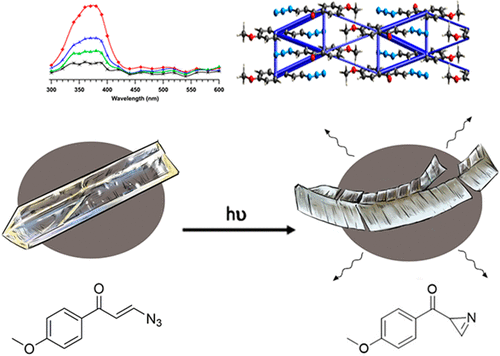当前位置:
X-MOL 学术
›
J. Am. Chem. Soc.
›
论文详情
Our official English website, www.x-mol.net, welcomes your feedback! (Note: you will need to create a separate account there.)
Cracking Under Internal Pressure: Photodynamic Behavior of Vinyl Azide Crystals Through N2 Release
Journal of the American Chemical Society ( IF 15.0 ) Pub Date : 2020-09-29 , DOI: 10.1021/jacs.0c07830 Dylan J. Shields 1 , Durga Prasad Karothu 2 , Karthik Sambath 1 , Ranaweera A. A. Upul Ranaweera 1 , Stefan Schramm 2 , Alexander Duncan 1 , Benjamin Duncan 1 , Jeanette A. Krause 1 , Anna D. Gudmundsdottir 1 , Panče Naumov 2
Journal of the American Chemical Society ( IF 15.0 ) Pub Date : 2020-09-29 , DOI: 10.1021/jacs.0c07830 Dylan J. Shields 1 , Durga Prasad Karothu 2 , Karthik Sambath 1 , Ranaweera A. A. Upul Ranaweera 1 , Stefan Schramm 2 , Alexander Duncan 1 , Benjamin Duncan 1 , Jeanette A. Krause 1 , Anna D. Gudmundsdottir 1 , Panče Naumov 2
Affiliation

|
When exposed to UV light, single crystals of the vinyl azides 3-azido-1-phenylpropenone (1a), 3-azido-1-(4-methoxyphenyl)propenone (1b), and 3-azido-1-(4-chlorophenyl)propenone (1c) exhibit dramatic mechanical effects by cracking or bending with the release of N2. Mechanistic studies using laser flash photolysis, supported by quantum mechanical calculations, show that each of the vinyl azides degrades through a vinylnitrene intermediate. However, despite having very similar crystal packing motifs, the three compounds exhibit distinct photomechanical responses in bulk crystals. While the crystals of 1a delaminate and release gaseous N2 indiscriminately under paraffin oil, the crystals of 1b and 1c visibly expand, bend, and fracture, mainly along specific crystallographic faces, before releasing N2. The photochemical analysis suggests that the observed expansion is due to internal pressure exerted by the gaseous product in the crystal lattices of these materials. Lattice energy calculations, supported by nanoindentation experiments, show significant differences in the respective lattice energies. The calculations identify critical features in the crystal structures of 1b and 1c where elastic energy accumulates during gas release, which correspond to the direction of the observed cracks. This study highlights the hitherto untapped potential of photochemical gas release to elicit a photomechanical response and motility of photoreactive molecular crystals.
中文翻译:

内压开裂:乙烯基叠氮化物晶体通过 N2 释放的光动力学行为
当暴露在紫外线下时,乙烯基叠氮化物 3-叠氮基-1-苯基丙烯酮 (1a)、3-叠氮基-1-(4-甲氧基苯基)丙烯酮 (1b) 和 3-叠氮基-1-(4-氯苯基) 的单晶)丙烯酮 (1c) 会随着 N2 的释放而开裂或弯曲,从而表现出显着的机械效应。在量子力学计算的支持下,使用激光闪光光解的机理研究表明,每种乙烯基叠氮化物都通过乙烯基腈中间体降解。然而,尽管具有非常相似的晶体堆积基序,这三种化合物在块状晶体中表现出不同的光机械响应。虽然 1a 的晶体在石蜡油下不分青红皂白地分层并释放气态 N2,但 1b 和 1c 的晶体在释放 N2 之前主要沿着特定的晶面发生明显的膨胀、弯曲和断裂。光化学分析表明,观察到的膨胀是由于这些材料的晶格中的气态产物施加的内部压力。由纳米压痕实验支持的晶格能量计算显示出各自晶格能量的显着差异。计算确定了 1b 和 1c 的晶体结构中的关键特征,其中弹性能量在气体释放过程中积累,这对应于观察到的裂缝的方向。这项研究强调了迄今为止尚未开发的光化学气体释放潜力,以引发光反应分子晶体的光机械响应和运动性。显示出各自晶格能量的显着差异。计算确定了 1b 和 1c 的晶体结构中的关键特征,其中弹性能量在气体释放过程中积累,这对应于观察到的裂缝的方向。这项研究强调了迄今为止尚未开发的光化学气体释放潜力,以引发光反应分子晶体的光机械响应和运动性。显示出各自晶格能量的显着差异。计算确定了 1b 和 1c 的晶体结构中的关键特征,其中弹性能量在气体释放过程中积累,这对应于观察到的裂缝的方向。这项研究强调了迄今为止尚未开发的光化学气体释放潜力,以引发光反应分子晶体的光机械响应和运动性。
更新日期:2020-09-29
中文翻译:

内压开裂:乙烯基叠氮化物晶体通过 N2 释放的光动力学行为
当暴露在紫外线下时,乙烯基叠氮化物 3-叠氮基-1-苯基丙烯酮 (1a)、3-叠氮基-1-(4-甲氧基苯基)丙烯酮 (1b) 和 3-叠氮基-1-(4-氯苯基) 的单晶)丙烯酮 (1c) 会随着 N2 的释放而开裂或弯曲,从而表现出显着的机械效应。在量子力学计算的支持下,使用激光闪光光解的机理研究表明,每种乙烯基叠氮化物都通过乙烯基腈中间体降解。然而,尽管具有非常相似的晶体堆积基序,这三种化合物在块状晶体中表现出不同的光机械响应。虽然 1a 的晶体在石蜡油下不分青红皂白地分层并释放气态 N2,但 1b 和 1c 的晶体在释放 N2 之前主要沿着特定的晶面发生明显的膨胀、弯曲和断裂。光化学分析表明,观察到的膨胀是由于这些材料的晶格中的气态产物施加的内部压力。由纳米压痕实验支持的晶格能量计算显示出各自晶格能量的显着差异。计算确定了 1b 和 1c 的晶体结构中的关键特征,其中弹性能量在气体释放过程中积累,这对应于观察到的裂缝的方向。这项研究强调了迄今为止尚未开发的光化学气体释放潜力,以引发光反应分子晶体的光机械响应和运动性。显示出各自晶格能量的显着差异。计算确定了 1b 和 1c 的晶体结构中的关键特征,其中弹性能量在气体释放过程中积累,这对应于观察到的裂缝的方向。这项研究强调了迄今为止尚未开发的光化学气体释放潜力,以引发光反应分子晶体的光机械响应和运动性。显示出各自晶格能量的显着差异。计算确定了 1b 和 1c 的晶体结构中的关键特征,其中弹性能量在气体释放过程中积累,这对应于观察到的裂缝的方向。这项研究强调了迄今为止尚未开发的光化学气体释放潜力,以引发光反应分子晶体的光机械响应和运动性。



























 京公网安备 11010802027423号
京公网安备 11010802027423号